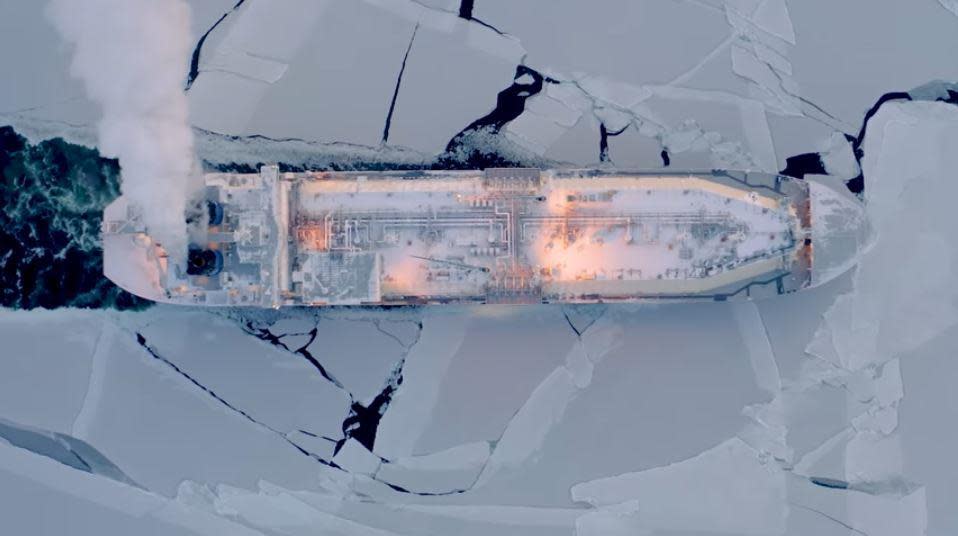Russian tanker cuts previously impossible path through warming Arctic

Moscow — A Russian natural gas tanker has completed an experimental round trip along the Northern Sea Route — the first time the path across the Arctic has been forged at this time of year. The voyage by the Christophe de Margerie tanker through the ice is the latest visual indicator of climate change in the delicate region. The tanker, run by the Sovcomflot shipping company, returned to the remote Russian gas terminal at Sabetta on February 19, taking Russia one step closer to its goal of year-round commercial navigation through the warming Arctic.
The LNG (liquefied natural gas) tanker set out from the Chinese port of Jiangsu on January 27 after delivering its cargo. It entered the Northern Sea Route, which traverses Russia's north coast, a few days later near Cape Dezhnev, where it was met by the Russian nuclear icebreaker 50 Let Pobedy (50 Years of Victory). Together they completed the 2,500-nautical-mile voyage through the ice in 11 days and 10 hours.
The vessel managed to complete the first leg of the trip from Russia to China without an icebreaker. Both of the journeys broke records for winter navigation due to the changing climate in the Arctic allowing passage through thinner ice. Using the Northern Sea Route enables shippers in Russia and other countries to avoid a much lengthier southern journey around Europe, the Middle East and all of southern Asia, saving millions of dollars.
The Northern Sea Route through the Arctic north of Siberia is now open. In February.There is no multi-year ice left there anymore.We are in a climate emergency. https://t.co/HwOSSkD6o7
— Eric Holthaus (@EricHolthaus) February 21, 2021
The deepest ice encountered by the ships was about 5 feet thick. The vessels encountered no multi-year buildup of old ice on the route, however, and meteorologist and journalist Eric Holthaus called that a clear indicator of "a climate emergency."
Last May, the Christophe de Margerie became the first large-capacity cargo vessel to complete an eastbound transit of the Northern Sea Route, two months earlier in the year than the journey traditionally has been made.

"As a result of the early Northern Sea Route (NSR) voyage completed by Christophe de Margerie in May 2020, as well as the current NSR voyage, the navigation in the Eastern part of the Arctic was practically doubled," Sovcomflot CEO Igor Tonkovidov said earlier this month. He noted that for decades the transit route along that segment of the NSR had typically remained closed by ice from November until July.
"The Arctic is ours"
Novatek, the company that operates the LNG gas plant in Sabetta, plans to continue experimental voyages eastward along the Northern Sea Route, with the next one scheduled this spring, the daily Russian business newspaper Kommersant quoted the company's boss as saying.

Last year, Russia moved almost 33 million tons of cargo along the Northern Sea Route, including over 18 million tons of LNG. Cargo traffic along the NSR has grown almost fivefold in the past five years alone. "The route can handle a lot more than that," Russian Deputy Prime Minister Yury Trutnev said during a government meeting last week. He said that according to a decree issued by President Vladimir Putin, cargo traffic along the NSR should rise to 80 million tons per year by 2024. "One way that target can be achieved is by expanding the period of Arctic navigation," Trutnev said.
To help it achieve its lucrative Arctic ambitions, Russia has been renewing its unique civilian fleet of nuclear-powered icebreakers. Last year Russia unveiled the new flagship of that fleet, the Arktika, said to be the world's biggest and most powerful.

"Russia's Arctic attracts many who are interested in its resources," St. Petersburg Governor Georgy Poltavchenko said at the launch ceremony. "But the Arctic is ours, and we've proved it."
By the end of 2022 Russia plans to launch two more ships in the same series.
Environmentalists have raised concern over the growing presence of nuclear power in the sensitive Arctic region, which is already plagued by problems linked to climate change.
According to some estimates, the Arctic holds oil and gas reserves equivalent to 412 billion barrels of oil, about 22% of the world's undiscovered oil and gas.
Cabinet nominees face Senate grilling as Biden prepares to meet with Canadian leader

